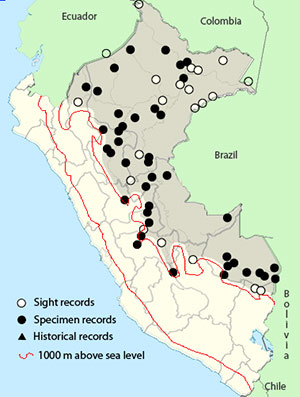Order: Coraciiformes | Family: Momotidae | IUCN Status: Least Concern

Age: Adult | Sex: Unknown | Loc. Manu National Park

Age: Adult | Sex: Unknown | Loc. Loreto, Peru

Age: Adult | Sex: Unknown | Loc. Mato Grosso, Brasil

Age: Adult | Sex: Unknown | Loc. Manu National Park
Status: The Amazonian Motmot is generally uncommon in floodplain forests. It sits still and can be difficult to see, despite their size. It also occurs in Co, Ec, Br, and Bo.
Name in Spanish: Relojero Amazónico.
Sub-species: Amazonian Motmot (Momotus momota) (Linnaeus, 1766).
M.m. microstephanus: E Ecuador, NE Peru and NW Brazil.
M. m. ignobilis: E Amazonian Peru and w Brazil.
Meaning of Name: Momotus: A word derived from the word Motmot, which is supposed to be the native Mexican name for Motmots.
 Voice
VoiceReferences:
-
- Species range based on: Schulenberg, T. S., D. F. Stotz, and L. Rico. 2006. Distribution maps of the birds of Peru, version 1.0. Environment, Culture & Conservation (ECCo). The Field Museum. http://fm2.fieldmuseum.org/uw_test/birdsofperu on 11/09/2014.